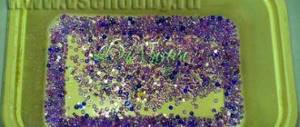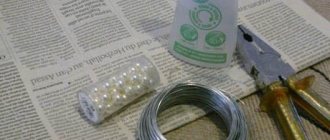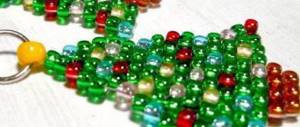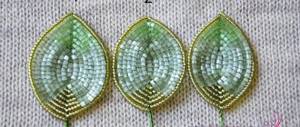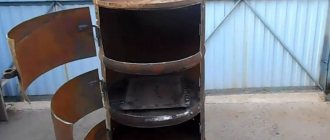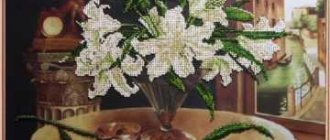Small beaded roses
Small flowers can be used to decorate pins, brooches, and elastic bands.
For work, prepare:
- wire 0.3 mm in diameter;
- nippers or scissors;
- beads of two colors;
- threads
A small beaded rose for beginners is woven according to the following pattern:
- String 9 beads onto the wire.
- Make a loop, secure the ends of the wire by twisting them 2-3 turns.
- On the same wire, make 2 similar arcs next to each other.
- Place seven beads on the tip of the base.
- Pass the wire through the middle bead of the first arc.
- Then add 2 more beads, thread the edge of the wire through the middle of the second arc.
- Put on 2 more beads and thread the tip of the base through the middle of the outer arc.
- Add 7 more beads to the wire and secure its edge at the bottom of the petal.
- Using this pattern, weave 5-7 petals.
- Separately, collect 14 beads.
- Twist them together. This will be the sepal.
- Collect a bud from the petals, fix the sepal at the bottom.
Description of shell weaving
We cut off 9 pieces of wire, 25 cm each - this is for the bottom, the lid is made in the same way.
We take 2 wires and twist them together from the middle in this way:
We take the next one, and twist it in the same way from the middle with one “whisker”, screw the next one to it, etc., until we get such a “spider”, or rather, a completely stable frame for our shell.
To one tendril we screw the tip of a wire 3 meters long, onto which we collect beads. We weave the initial row on 4 tendrils: beads, wrap 1 tendril, skip 1. Those. the initial row is only 4 beads.
1st row we use all the antennae - 9 beads, 2nd row between the antennae 2 beads each, 18 in total.
We continue to weave until the 16th row, since the beads are usually of different sizes, then in the future the number of beads between the antennae may be different. The main thing is to try to ensure that everything is even and the sectors are approximately the same in width. We put pearls on the ends of the antennae (except for the beginning row) and, bending them slightly, make a couple of turns, cut off the remaining wire and carefully hide the tip.
Having made the other half in the same way, we connect them with the loose (ninth) tendrils, and slightly bend the middle of the sectors upward to get a wavy edge. In principle, the shell is ready, but it will not stand. A stand is needed.
By this time, the rose (or other flower) and leaves should be ready.
We take an aluminum wire, bend the tip 4 cm, attach a flower to it, insert it into the shell from the back side, secure it all with the remaining connecting tendril, adhesive plaster, thread or tape.
We give the wire the shape of the stand that you would like. It can be a spiral, a ring, as your imagination tells you. Then we wrap the stand with what we have - braid, ribbon, string, maybe even a string of beads.
And we admire the beauty created.
Tell your friends about the article:
MK – Beaded brooch “Rowan Brush”
Master class - Sakura with a fan
Roses in a pot
A lush bush rose will decorate the interior of any living room. To create a bush you will need:
- wire;
- yellow beads for the bud;
- green beads;
- skewer;
- scissors or tweezers;
- green floss threads;
- pot;
- Styrofoam;
- expanded clay drainage.
Scheme of a beaded rose in a pot:
- Thread 1 green bead onto 30 cm of wire and lower it towards the center.
- String 2 more beads, passing them through both ends of the wire and tightening.
- In the same way, weave 4 rows of 3, 4, 3 and 2 beads in each.
- To secure, the ends of the working thread must be twisted into a knot.
- Make 6 such sepals.
- Weave the petals in the same way. On a 60 cm long wire, make 8 rows of 1, 2, 4, 6, 8, 10, 12, 14 yellow beads.
- 9th row - edging. You need to string 9 beads onto each end of the wire and pull them through 1 row.
- Tie the ends into a knot. Weave 5 petals, for each of which you need to measure and cut the wire again.
- Also weave 4 large rose petals in 9 rows.
- Make 11 leaves, consisting of 11 rows of 1, 2, 3, 4, 5, 6, 6, 5, 4, 3, 2, 1 green beads.
- Bend the rose petals into an arc.
- To assemble on a skewer, first connect the small, then the large petals.
- Cover the bud from below with sepals.
- Distribute large leaves evenly along the entire length of the stem.
- Wrap the stem with floss threads.
- Make other roses in the same way.
- Cut a circle out of foam plastic, slightly smaller than the diameter of the pot.
- Insert the foam into the pot and stick the roses into it.
- Cover with drainage on top.
Fifth circle of petals
The fifth circle of petals includes 4 petals and is woven on three axes. They collect from 3 to 1 beads from right to left, but after the first circle you will have to collect one more bead on the middle axis. Before the third circle of arcs, you need to collect 1 bead on the outer axes, and in total you should get 15 arcs (8 front and 7 back).
The lower part needs to be made round, and the shape of the upper part does not really matter. At the end of the weaving, the petals are given a cup-shaped shape and alternately tied to the base of the future rose with threads.
At the last stage, it is necessary to secure the position of the petals with glue, preferably acrylic. It is applied in a small drop at the places where the petals touch, so that in the future they do not fall apart under the weight of their own weight.
In addition to the rose, you can weave a couple of buds, the weaving process of which includes the first two stages, which are listed above. You can make the second circle of bud petals either sharp or round.
Rose from beads - step-by-step master class
Rose is a very popular and almost everyone's favorite flower. But, unfortunately, all its beauty quickly fades. You can make this flower with your own hands from beads. A beaded rose will delight you with its blooming appearance all year round. If you don’t know how to make a rose from beads, then this master class with step-by-step photos will help you master the technique of weaving roses from beads.
To weave a rose you will need:
- Beads of three colors - pink, white, green. Size 11 or 10 (Czech beads), and if Chinese beads then size 12.
- For a bud, a total of 140 grams of beads, for leaves 80 grams.
- The wire is 0.3mm, 0.4mm in diameter and very thick for the rod.
- Floral ribbon.
- Glue (transparent polyurethane).
The rose we will weave will be big. The diameter of the bud is 12 cm. The height of the entire rose depends on the rod from which you will make the trunk.
Decorating the interior
Bead decor can be made in different ways: string it on threads, wire, or weave it into the desired composition. Beads can be glued to leather, wood, and ceramics. What can you make from beads and how to decorate your home? The simplest thing is to create a translucent screen-curtain in the room, which can also be hung in the doorway. To do this, simply string small beads onto long threads. Such a screen will serve not only for decoration, but also for zoning the room.
For Feng Shui lovers, you can create “wind chimes” using small strings of beads, beads, feathers and ribbons. You can also make beautiful tassels from threads for gartering curtains, canopies, decor for lampshades, and toys. All this is accessible even to a novice master. Making more complex crafts will require perseverance, desire and more experience.
Related article: Do-it-yourself fabric bow on your head or on a dress with a master class
Any room will be decorated with cute bouquets of flowers. Flowers made from beads look natural, elegant and do not require care. They will be a godsend for those who do not like real indoor plants, are allergic to them, or are leaving home for a long time.
Lovers of painting and handicrafts can decorate the walls with stylish panels or paintings. This is, of course, very labor-intensive work, but the result will exceed all expectations.
The main thing is to successfully select the beads according to the colors and do everything carefully, then your acquaintances and friends will be delighted with the result of the work.
All decorative items made with your own hands will make the interior of an apartment or house cozy, give it uniqueness and originality, and give it the warmth of the soul. You can learn more about the technique of weaving openwork roses from a selection of videos.
Leaves for roses made of beads
We weave pointed leaves according to the pattern: We place 5 beads on the axis. The length of the wire for weaving is 77 cm. We make a pair of leaves from 14 arcs (7 turns) and one leaf from 12 arcs (6 turns) or vice versa, a pair of leaves from 12 arcs and one leaf from 14 arcs. In general, which leaves do you like best? We wrap the wire around each leaf with floral tape. We fasten the finished leaves together and also wrap them with floral tape.
Next, we attach the leaves to the stem of the flower.
That's it, the weaving of one rose is finished. Now you know how to weave a rose from beads. I hope the master class is clear to you, and you can use it to weave gorgeous roses from beads in any quantity. You can see the finished composition in this photo album.
Leaves
The leaves are made in the same way as the round petals. There should be 18 of them in total for the composition, and for one rose the number is chosen at your own discretion.
Leaf pattern: 7 beads on the axis and 11 arcs on each side (large), 7 beads on the base and 9 arcs on both sides (small). The leaves are collected in threes per branch, after which the entire composition of roses and buds is prepared. You need to assemble it by wrapping each part with threads so that nothing dangles and all the elements are held tightly.
To give the finished look, you need to plant the rose in a pot or bowl on plaster.
biserok.org May 11, 2013 4 comments »
